Do you see standing water on your property after a storm? Are your downspouts flowing down drives or eroding the ground?
If so, then you might have a stormwater runoff problem. Even log cabins that are tucked back into nature can contribute to runoff issues. However, there are several tools that log homeowners can use to take runoff matters into their own hands.
What is Stormwater Runoff?
Stormwater runoff is a severe and growing problem across the country, especially in urban areas. Roofs, sidewalks, and parking lots take away the natural absorption of the land. When it rains, that water collects and flows down these surfaces.
As urban environments aren’t known to be clean, runoff collects pollution and debris. Eventually, that toxic water flows through gutters and pipes to outflow into natural waterways—and all of that pollution goes with it.
The result is ecological destruction, stream and river erosion, and degraded water quality.
As owners of log homes, many urban issues seem distant. However, all log homes have roofs, driveways, and other factors contributing to runoff. Here are a few impactful ways to reduce runoff, and use it to your advantage.
Rain Barrels and Cisterns
Rain barrels are an easy way to capture the runoff from the roof of your log home. Much as the name suggests, these barrels are vessels that hold up to 55 gallons of rainwater. Aim your downspouts to flow into the barrels. Or, mount direct flow piping from the eves directly into the barrels. This diverts water away from the home, which is especially important for log and exposed timber-based houses.
Collecting rainwater from the roof is nothing to scoff at. If just 1 inch of water falls on a 1,000-square-foot roof, 623 gallons of water will fall off the roof. You can use that water for irrigation, flushing toilets, running fountains, and more.
Another option is a cistern. Much like a rain barrel, cisterns collect rainwater. Unlike rain barrels, cisterns hold up to 20,000 gallons of water. They are great options for those living on rural properties, or those that want to focus on water conservation.
Indeed, 20,000 gallons of free water goes a long way. As well, many cisterns have features to create a potable water environment.
Rain barrels and cisterns have one final benefit. They divert rainwater that would otherwise become stormwater runoff. Any collected water doesn’t cause damage downstream. Also, by reusing the water in a controlled method (such as watering the lawn), the water rejoins the natural water cycle.
Rain Gardens
If your home does not need rain barrels, then consider a rain garden to control rainfall runoff. Constructed on slopes or in areas where rainwater flows, rain gardens use plants’ root systems to collect and filter runoff.
A rain garden is a collection of native trees, bushes, grasses, and other plants that are planted over substrate. Suitable in any size, rain gardens interrupt stormwater runoff by creating an extra-permeable area. The collected runoff is then naturally filtered and returned to nature.
Keep rain gardens at least 10 feet away from the home to avoid flooding the foundation. Never build over a septic tank. For the first couple of years, water regularly, mulch, and weed when needed. After the first few years, a rain garden becomes self-sustaining, even during the winter.
Rain gardens also bring many other benefits, including:
- Creating a natural habitat for birds, insects, and other animals.
- Bolstering native vegetation to support the local environment.
- Added property value and curb appeal.
Rain gardens benefit nearly any property, especially log homes. Directing water away from the foundation and back into the ground is essential for the long-term maintenance of the home’s foundation. And, when fully grown, rain gardens make spectacular visual additions to your property.
Buffer Zones
If your property borders a river, stream, or other waterways, consider improving the natural riparian buffers. Riparian buffers are strips of dense vegetation, trees, and rich soil alongside waterways. The unique properties of fertile topsoil over shallow groundwater create impressive waterway protections.
When water naturally flows downhill, it eventually finds a creek, stream, or river. Riparian buffers slow the inflow, thus filtering any runoff before it hits the waterway.
If you have a waterway on your property, enhance the riparian buffer yourself. Like a rain garden, use native plants that thrive in a riparian situation. Plant deep-rooted trees, shrubs, and perennial plants. Leave the areas next to the waterway unmanaged for optimum runoff control. The areas farther away from a waterway should stay relatively maintained.
Native plants will thrive in riparian conditions, and they will increase the erosion and filtration control of the ground.
Final Thoughts
Log homes have plenty of means to manage stormwater runoff. From rain barrels to buffer zones, log homes’ closer connection with nature makes them perfect stewards of their property.
As a log home owner, protect the land around you. Use rain gardens to create new habitats while combating stormwater runoff. Store rainwater in cisterns to keep it from causing further downstream damage. These may seem like small steps, but for the environment, every step counts.
– Rachel Perez




